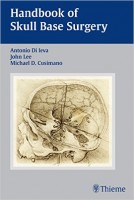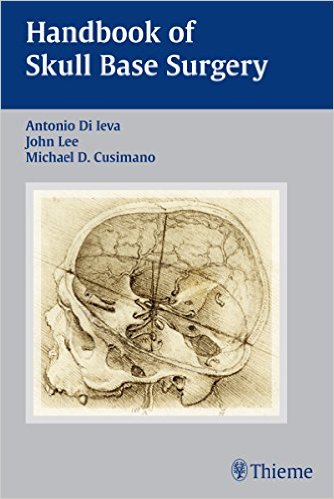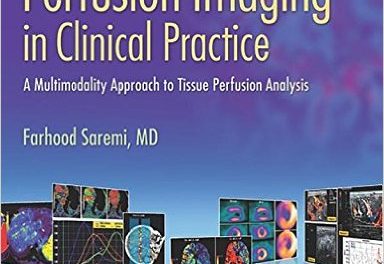 Editors: Antonio di Ieva, MD; John M. Lee, MD; and Michael D. Cusimano, MD
Editors: Antonio di Ieva, MD; John M. Lee, MD; and Michael D. Cusimano, MD
Publisher: Thieme – 978 pages, with 174 illustrations
Book Review by: Nano Khilnani
The editors write that skull base surgery is one of the most complex fields in medical practice, requiring mastery of at least four surgical specialties and the attendant knowledge of the anatomy, physiology, and pathophysiology in those areas. But success in skull base surgery also requires the ability to bring together the efforts of others in related disciplines, and work with them collaboratively for the ultimate benefit of the patient.
People afflicted by lesions of the skull base have benefitted from the multidisciplinary collaboration in this field. But several developments in skull base surgery have particularly helped advance the field of skull base surgery. Among others, they are:
- Advanced imaging
- Endoscopic techniques
- Development of radiosurgery
- Improvements in technology
- Multidisciplinary clinic
Thirty-three professors and practitioners of head and neck surgery and neurosurgery, as well as craniomaxillofacial surgery, interventional radiology, neuroophthalmology, orbital surgery, plastic surgery, and radiation oncology – from Australia, Canada, Italy, Japan, the Netherlands, the United Kingdom, and the United States – wrote the 41 chapters of this book which are organized around three Sections:
- Section I. History, Principles and Preoperative Assessment
- Section II. Skull Base Surgery
- Postoperative and Surgery-Related Aspects
Over the years, there has been increasing subspecialization in skull base surgery. This has certainly enlarged the knowledge base of the surgeons and led to more successful surgeries. But it has also led to increasingly working together among specialists and subspecialists to find solutions to problems.
Section I, with chapters 1 through 13, deals with issues that form the foundation of skull base surgery. You will find summaries of the anatomical, embryological, imaging and radiological aspects of surgery in the skull base. You will also find in this section, chapters that contain discussions of the principles of endocrinology, neurology, ophthalmology, otorhinolaryngology and pathology as they relate to surgery. This section includes chapters on anesthesia and instrumentation.
Section II has chapters 14 through 28, which cover the different types of approaches, such as transcranial, transfacial, endoscopic transphenoidal, and endoscopic keyhole approaches. This section also contains chapters that deal with anterior skull base, middle skull base, and posterior skull base surgeries, including meningioma surgery; and intraorbital pathologies and surgical approaches to them. You will also find chapters on: cerebrovasacular surgery, cranial nerve reconstruction, the craniovertebral junction, dural sinus management, extracranial tumors involving the skull base, and skull base reconstruction.
Section III, with chapters 29 through 41, has chapters on postoperative care surgery-related matters. Among those topics are: biology and genetics of skull base tumors, cerebrospinal fluid fistula, chemotherapy of skull base malignancies, complications management, congenital encephaloceles, emergencies and acute situations, nursing, pediatric skull base, quality of life, role of radiation, skull base infections, skull base traumatology, and training in skull base surgery.
The chapters in this book contain, among others, these important features to make it a very valuable resource in skull base surgery:
- Bullet-point information for easier remembrance and recall
- Definitions
- Detailed line drawings
- Lists of references for further exploration
- Pearls in surgical anatomy
- Tables with helpful summaries of key data
This book contains step-by-step instructions on how to perform various surgeries in the skull base. It is a compact handbook yet quite a comprehensive one with a wealth of information in textual and visual forms. It is an essential addition to the library of anyone working in the field of skull base surgery.
Editors:
Antonio di Ieva, MD, PhD is Neurosurgeon and Associate Professor at Macquarie University Hospital; Honorary Research Fellow at Garvan Institute of Medical Research in Sydney, Australia; and Privadotzent of Neuroanatomy at Medical University of Vienna in Vienna, Austria. He is an alumnus of the University of Toronto in Ontario, Canada.
John M. Lee, MD, FRCSC, MSc is Assistant Professor in the Department of Otololaryngology – Head and Neck Surgery at St. Michael’s Hospital at the University of Toronto in Ontario, Canada.
Michael D. Cusimano, MD, MHPE, FRCSC, PhD, FACS, FAANS is Professor of Neurosurgery, Education and Public Health in the Division of Neurosurgery at St. Michael’s Hospital at the University of Toronto in Ontario, Canada.







